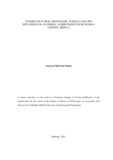| dc.description.abstract | Education is a human activity that fashions and models mankind for the society. It is for this reason that the Kenyan government has put emphasis on the pursuit quality education for its citizens since independence. The journey to realizing quality of education has had an implication on the funding policy. On February 11th, 2008, Free Day Secondary Education (FDSE) policy was introduced by the Government of Kenya with the aim of expanding access, equity as well as quality of education. The government of Kenya spends over 10% of the total annual budget on education to boost quality in the sector that should result in improved academic performance by learners in national examinations. However, funding of education especially at secondary school level still remains contentious as seen in the many calls by the public and even the Government of the day to reduce the burden on parents in terms of funding. The year 2018 marked the beginning of the full implementation of FDSE where all public day secondary school students were exempted from all tuition obligations. The study investigated funding practices in public secondary schools and their influence on academic achievement in Bungoma County. This was achieved by establishing the funding practices used in public secondary schools, analyzing the association of funding practices on the adequacy of teaching learning materials as well as that of the funding practices and the adequacy of physical infrastructure and investigating the association between funding practices on educational resources on learners’ academic achievement in public secondary schools. A mixed research design was employed in the study. The target population consisted of 252 public secondary schools of which 36 constituted the study population. Stratified sampling was employed to ensure representation of all categories of public secondary schools and sub-counties in the county. Of the selected schools, the principals, bursars and heads of academic departments (HoDs) were respondents in this study. The County Director of Education was also a respondent in this study. The instruments for data collection for the study included the questionnaires, structured interview schedules and document analysis schedule. The SPSS Package was used in the analysis of quantitative data. Descriptive statistics using standard deviation and mean were utilized to organize, analyze, present and describe data from respondents by using tables and figures while inferential statistics were used to determine the association of funding practices on adequacy of teaching and learning resources and infrastructure. The Spearman’s Rho correlations was used to determine the possibility of existence of any relationship between variables of the study. The study established that the main source of funding for public secondary schools in Bungoma County was FDSE and parents fees payment. It also found out that resource allocation is largely influenced by departmental budget, type of school and availability of funds. The study established that funding practices had a positive association with the physical infrastructure provision. It also found that there was a positive association between the funding practices and the teaching learning materials. The study determined that the provision of educational resources had a positive association with learners’ academic achievement. On the overall the funding practices had positive association with provision of adequate physical resources, teaching and learning resources and academic achievement. The findings will be useful to policy makers in terms of making informed decisions that will guide better provision of learning resources in secondary schools. The study recommended a criteria of apportioning of funds available in the ratios of 0.38 on provision of staffing and training, 0.32 on teaching learning resources and 0.30 on physical facilities in order to realize higher academic achievement. | en_US |

